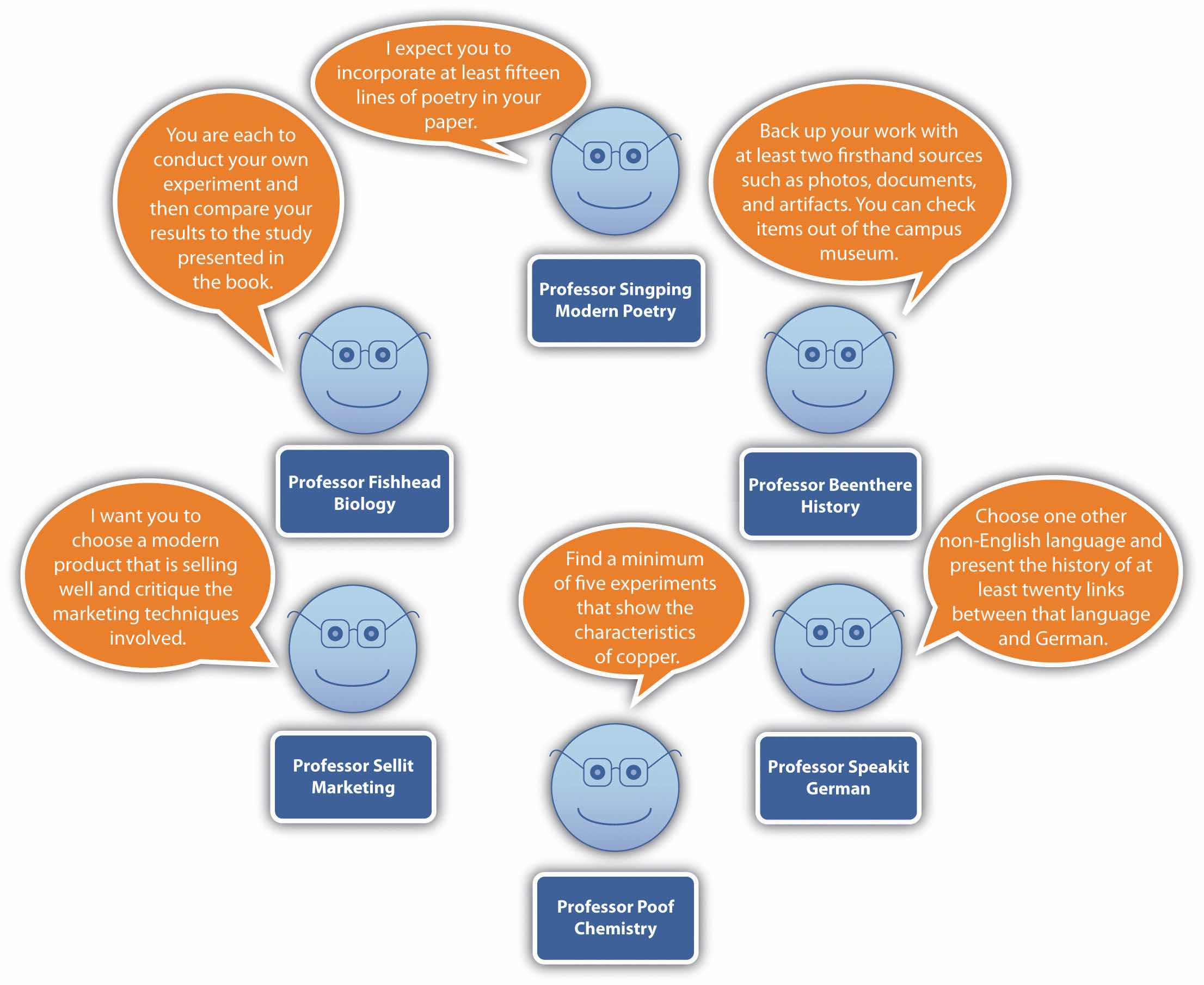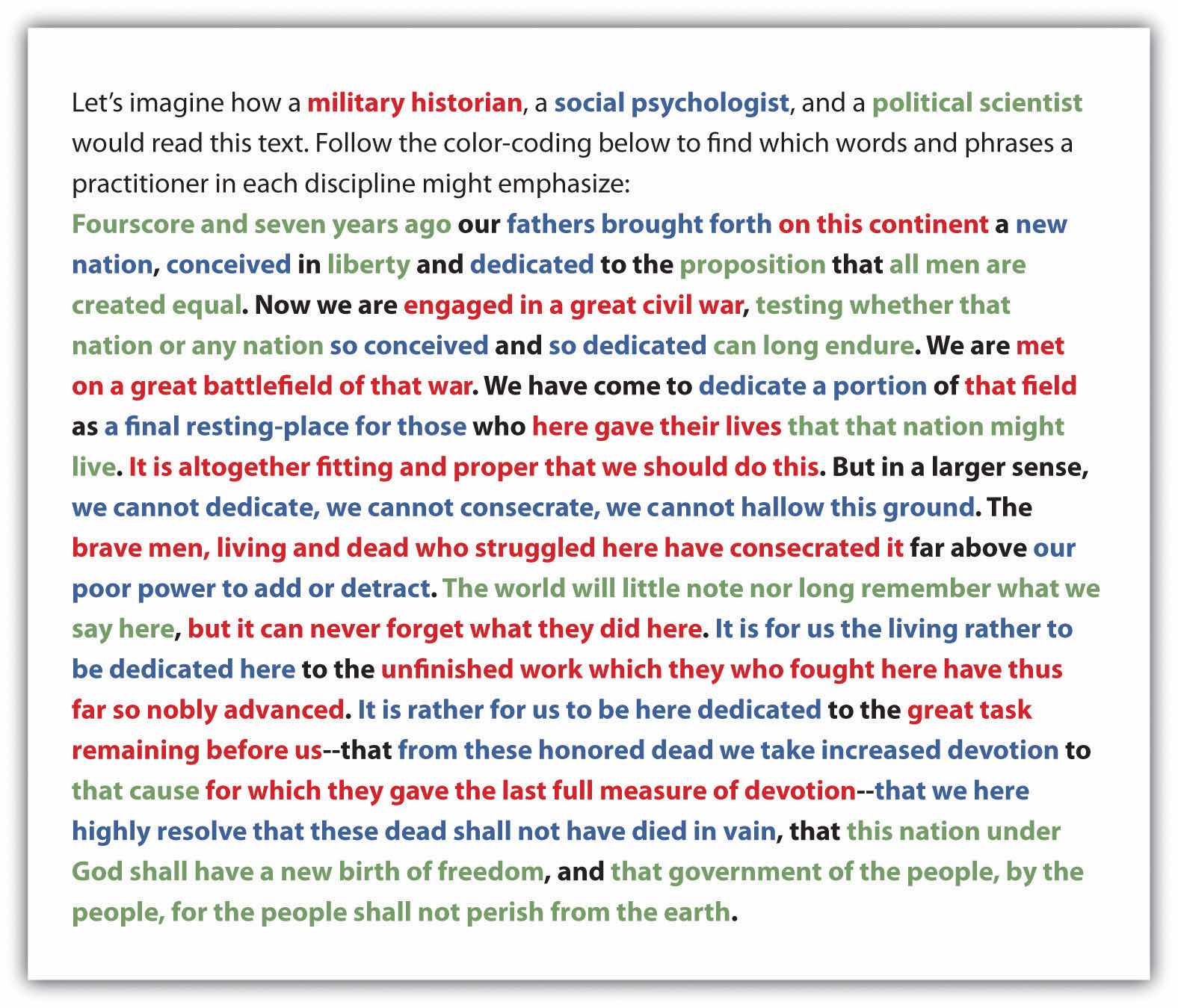Most college writing has some basic features in common: a sense of ethical responsibility and the use of credible and credited sources, critical thinking, and sound argumentation. In addition to these common features, each academic discipline, over many generations, has developed its own specific methods of asking questions and sharing answers. This chapter will show you how to use the lenses of various academic disciplines to develop your writing, reading, and thinking.
The following table shows one version of the main academic disciplinesAn academic category characterized by particular areas of study, methods of inquiry, and standards of proof. and some of their branches.
| Discipline | Branch Examples |
|---|---|
| Business | Accounting, economics, finance, management, marketing |
| Humanities | Art, history, languages, literature, music, philosophy, religion, theater |
| Natural and applied sciences | Biology, chemistry, computer science, engineering, geology, mathematics, physics, medicine |
| Social sciences | Anthropology, education, geography, law, political science, psychology, sociology |
Since the makeup of the different branches is always in flux and since the history of any institution of higher education is complicated, you will likely find some overlapping and varying arrangements of disciplines at your college.
Part of your transition into higher education involves being aware that each discipline is a distinct discourse communityA particular system of communication developed over time within a discipline or social group. with specific vocabularies, styles, and modes of communication. Later in your college career, you will begin your writing apprenticeshipThe period of training and practice leading to command of a discipline and full participation in it academically or professionally. in a specific discipline by studying the formats of published articles within it. You will look for the following formal aspects of articles within that discipline and plan to emulate them in your work:
Different disciplines tend to recommend collecting different types of evidence from research sources. For example, biologists are typically required to do laboratory research; art historians often use details from a mix of primary and secondary sources (works of art and art criticism, respectively); social scientists are likely to gather data from a variety of research study reports and direct ethnographicA kind of research in anthropology and the social sciences geared toward the study of a specific group of people or segment of a society. observation, interviews, and fieldwork; and a political scientist uses demographicA kind of statistical measurement used in political science to reflect segments of a population. data from government surveys and opinion polls along with direct quotations from political candidates and party platforms.
Consider the following circle of professors. They are all asking their students to conduct research in a variety of ways using a variety of sources.

What’s required to complete a basic, introductory essay might essentially be the same across all disciplines, but some types of assignments require discipline-specific organizational features. For example, in business disciplines, documents such as résumés, memos, and product descriptions require a specialized organization. Science and engineering students follow specific conventions as they write lab reports and keep notebooks that include their drawings and results of their experiments. Students in the social sciences and the humanities often use specialized formatting to develop research papers, literature reviews, and book reviews.
Part of your apprenticeship will involve understanding the conventions of a discipline’s key genres. If you are reading or writing texts in the social sciences, for example, you will notice a meticulous emphasis on the specifics of methodology (especially key concepts surrounding the collection of data, such as reliability, validity, sample size, and variables) and a careful presentation of results and their significance. Laboratory reports in the natural and applied sciences emphasize a careful statement of the hypothesis and prediction of the experiment. They also take special care to account for the role of the observer and the nature of the measurements used in the investigation to ensure that it is replicable. An essay in the humanities on a piece of literature might spend more time setting a theoretical foundation for its interpretation, it might also more readily draw from a variety of other disciplines, and it might present its “findings” more as questions than as answers. As you are taking a variety of introductory college courses, try to familiarize yourself with the jargonThe specialized language of a discipline. of each discipline you encounter, paying attention to its specialized vocabulary and terminology. It might even help you make a list of terms in your notes.
Scholars also tend to ask discipline-related kinds of questions. For example, the question of “renewable energy” might be a research topic within different disciplines. The following list shows the types of questions that would accommodate the different disciplines:
Think about your entire course load this semester as a collection of disciplines. For each course you are taking, answer the following questions, checking your textbooks and other course materials and consulting with your instructors, if necessary:
After you’ve asked and answered these questions about each discipline in isolation, consider what underlying things your courses have in common, even if they approach the world very differently on the surface.
Based on the example at the end of this section, pick a topic that multiple disciplines study. Formulate four questions about the topic, one from each of any four different disciplines. Ideally choose a topic that might come up in four courses you are currently taking or have recently taken, or choose a topic of particular interest to you. Here are just a few examples to get you started:
Section 3.1 "Exploring Academic Disciplines" focused on the formal differences among various academic disciplines and their discourse communities. This section will explore the intellectual processes and concepts disciplines share in common. Even though you will eventually enter a discipline as an academic specialization (major) and as a career path (profession), the first couple of years of college may well be the best opportunity you will ever have to discover how disciplines are connected.
That process may be a rediscovery, given that in the early grades (K–5), you were probably educated by one primary teacher each year covering a set of subjects in a single room. Even though you likely covered each subject in turn, that elementary school classroom was much more conducive to making connections across disciplines than your middle school or high school environment. If you’ve been educated in public schools during the recent era of rigid standardization and multiple-choice testing conducted in the name of “accountability,” the disciplines may seem more separate from one another in your mind than they actually are. In some ways, the first two years of your college experience are a chance to recapture the connections across disciplines you probably made naturally in preschool and the elementary grades, if only at a basic level at the time.
In truth, all disciplines are strikingly similar. Together, they are the primary reason for the survival and evolution of our species. As humans, we have designed disciplines, over time, to help us understand our world better. New knowledge about the world is typically produced when a practitioner builds on a previous body of work in the discipline, most often by advancing it only slightly but significantly. We use academic and professional disciplines to conduct persistent, often unresolved conversations with one another.
Most colleges insist on a “core curriculum” to make sure you have the chance to be exposed to each major discipline at least once before you specialize and concentrate on one in particular. The signature “Aha!” moments of your intellectual journey in college will come every time you grasp a concept or a process in one course that reminds you of something you learned in another course entirely. Ironically the more of those “Aha!” moments you have in the first two years of college, the better you’ll be at your specialization because you’ll have that much more perspective about how the world around you fits together.
How can you learn to make those “Aha!” moments happen on purpose? In each course you take, instead of focusing merely on memorizing content for the purposes of passing an exam or writing an essay that regurgitates your professor’s lecture notes, learn to look for the key questions and controversies that animate the discipline and energize the professions in it. If you organize your understanding of a discipline around such questions and controversies, the details will make more sense to you, and you will find them easier to master.
Regardless of the discipline you choose to pursue, you will be arriving as an apprentice in the middle of an ongoing conversation. Disciplines have complicated histories you can’t be expected to master overnight. But learning to recognize the long-standing binary oppositionsA set of two opposite ways of looking at the world. in individual disciplines can help you make sense of the specific issues, themes, topics, and controversies you will encounter as a student and as a professional. Here are some very broadly stated examples of those binary oppositions.
| Discipline | Binary Oppositions (Binary A—Binary B) |
|---|---|
| Business | production—consumption |
| labor—capital | |
| Natural and applied sciences | empiricism—rationalism |
| observer—subject | |
| Social sciences | nature—nurture |
| free will—determinism | |
| Humanities | artist—culture |
| text—context |
These binary oppositions move freely from one discipline to another, often becoming more complicated as they do so. Consider a couple of examples:
Of course, these two brief summaries vastly oversimplify the evolution of multiple disciplines over generations of intellectual history. Like the chart of binary oppositions, they’re meant merely to inspire you at this point to begin to note the connections between disciplines. Learning to think, write, and function in interdisciplinary ways requires practice that begins at the level of close reading and gradually expands into the way you interact with your surroundings as a college student and working professional.
For a model of how to read and think through the disciplines, let’s draw on a short but very famous piece of writing (available through the Avalon Project in the Note 2.5 "Gallery of Web-Based Texts"), Abraham Lincoln’s “Address at the Dedication of the Gettysburg National Cemetery,” composed and delivered in November of 1863, several months after one of the bloodiest battles in the American Civil War.

Notice that each reader, regardless of academic background, needs a solid understanding of how rhetoric works (something we’ll cover in Chapter 4 "Joining the Conversation" in more detail). Each reader has been trained to use a specific disciplinary lens that causes certain passages to rise to prominence and certain insights to emerge.
But the real power of disciplines comes when these readers and their readings interact with each other. Imagine how a military historian could use social psychology to enrich an understanding of how a civilian population was motivated to support a war effort. Imagine how a political scientist could use military history to show how a peacetime, postwar governmental policy can trade on the outcome of a battle. Imagine how a social psychologist could use political science to uncover how a traumatized social structure can begin to heal itself through an embrace of shared governance.
As Lincoln would say, “It is altogether fitting and proper that we should do this.”